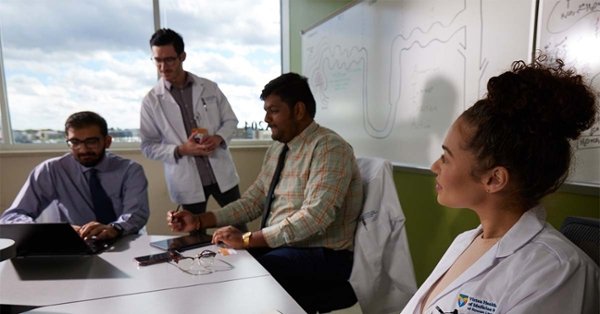Two tracks for two learning styles
Two tracks for two learning styles

At Rowan-Virtua School of Osteopathic Medicine (SOM), students have an opportunity to choose a path that best suits their learning style.
Students pursuing their Doctor of Osteopathy degree can apply for the more structured Synergistic Guided Learning (SGL) track or the more independent Problem-Based Learning (PBL) track.
Synergistic Guided Learning
Under a single-pass system, students in the SGL track learn the normal physiology, abnormal pathophysiology and pharmacology of each system of the body in one dedicated block. Although the SGL track is lecture-based, tools like the anatomy lab allow students to see pathology through hands-on work.
The SGL track’s set schedule of quizzes and exams helps second-year student Jordan Clark manage the workload.
“I like to know what I need to do for the week, the month and so on,” the aspiring emergency medicine physician said. “Having certain benchmarks ahead of you keeps you on top of your studying.”
Problem-Based Learning
In the PBL track, students take on a clinician role from their first day of medical school, learning through patient-case simulations. Students are guided by a faculty facilitator and software that allows them to perform a virtual physical exam and ask the same questions a physician would ask a real patient. Students compile a list of systems and underlying science topics to explore.
“PBL students cover the same topics that appear in a traditional medical school curriculum, but the participatory learning style is about students opening doors for themselves,” said Deanna Janora, M.D., director of Problem-Based Learning.
“It's the perfect balance,” said second-year student Rebecca Chae. “What you get done while you’re in class is efficient and meaningful, and the open schedule allows you to invest in activities like research or volunteering.”
Although other medical schools offer problem-based learning, Rowan-Virtua SOM is unique in offering multiple tracks in the first two years, Janora said.
Now part of Virtua Health College of Medicine & Life Sciences, Rowan-Virtua SOM has offered problem-based instruction for 20 years. Over the past decade, the popularity of the PBL track has soared from just eight students per year to 42 percent of the incoming class of 2022.
Prospective students can explore both tracks before enrolling by attending virtual presentations, sitting in on classes and speaking with both PBL and SGL student ambassadors during tours.
Applicants indicate their preferred curriculum track when they fill out their supplemental application. According to Paula Watkins, assistant dean for admissions, students typically are assigned to their first-choice preference.
Two paths to the same D.O. destination
Through activities like standardized patient encounters, community-involved primary care projects and skill-building weeks, SOM students in either track don’t just learn the foundations of medical science. They develop skills that shape them into the best possible physicians.
“Students in the SGL and PBL tracks are all getting to the same place and going into clerkships well-prepared,” said Jennifer Fischer, Ph.D., interim assistant dean of curriculum. “They’re learning about how we interact with one another and work collaboratively to achieve better patient outcomes, and that’s what sets our curriculum apart.”